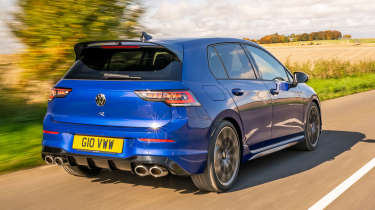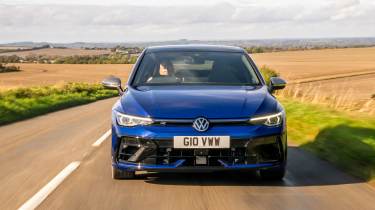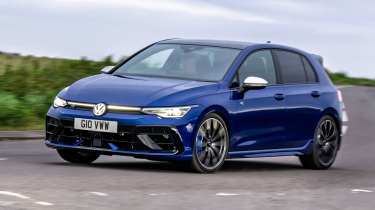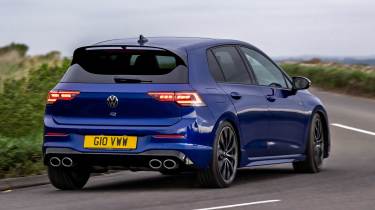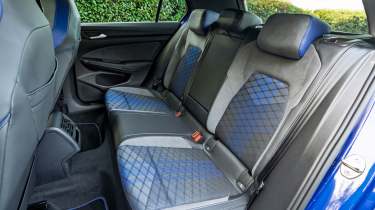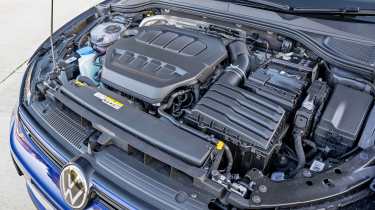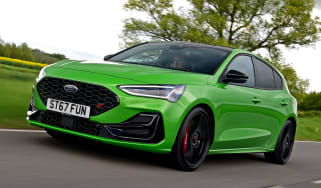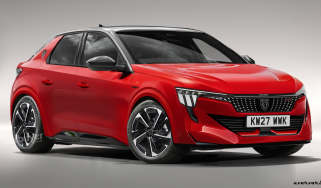Volkswagen Golf R review – the ultimate hot Golf
“The Volkswagen Golf R is one of the hottest Golfs ever, and handles very well”
Pros
- Very quick
- All-weather confidence
- Better to drive than before
Cons
- Some options should be standard
- Annoying touch-sensitive steering wheel buttons
- Underwhelming sound
Verdict – is the Volkswagen Golf R a good car?
The Volkswagen Golf was one of the first cars to get a hot hatch variant in the GTI, and R versions have taken things even further thanks to more power and four-wheel drive. As a result, it feels seriously quick and handles very well, even in the sort of adverse weather conditions we’re all too familiar with in Britain. However, some of the drama is lost with its underwhelming engine note. The facelift has improved things substantially, with easier-to-use infotainment and a slightly more playful driving experience that boosts its appeal amongst keen drivers.
Volkswagen Golf R models, specs and alternatives
Volkswagen has a rich history of producing hot hatches since right back in the 70s when it launched the original Volkswagen Golf GTI. Since then it’s extended the GTI badge to other models in its repertoire, and then in the late 90s it added another level of spice in the form of the Volkswagen Golf R32 – that car evolved into the Golf R super hatch as the most potent version in the lineup.
What really makes the R different from the GTI is its four-wheel drive system, meaning it can put down all its extra power onto the tarmac, grip even harder through the corners and inspire more confidence in its driver. Other manufacturers go toe-to-toe with the Golf R with rival super hatch models, such as the Mercedes-AMG A 35, Honda Civic Type R, Cupra Leon and Audi S3 – the latter two being closely related to the Golf itself.
 The UK's top 10 fastest hot hatchbacks 2025
The UK's top 10 fastest hot hatchbacks 2025
The Volkswagen Golf received a facelift in 2024, and that has brought extra revisions to the hot GTI and R models, too. The new sleeker headlights and exterior tweaks from the standard car have carried over to the R, giving it less of a fussy look, but bigger changes come under the surface. The facelifted Golf R now has 329bhp as standard; that’s the same as the special edition pre-facelift Golf R 20 Years model. 0-62mph takes just 4.6 seconds – to put that into perspective, that’s as fast as the original Audi R8 supercar. As with the outgoing Golf R, the new model is offered in hatchback and estate guise.
More reviews
Car trim reviews
In-depth reviews
- Volkswagen Golf R review – the ultimate hot Golf
- Volkswagen Golf review - the go-to family hatchback
- Volkswagen Golf R estate review
Used car reviews
While it may disappoint some drivers after more involvement, the latest Volkswagen Golf R is only available with an automatic gearbox. It’s hardly surprising, though, because most buyers of the previous-generation model got it with an automatic transmission, and with such low demand VW decided to axe the manual gearbox completely. We’ve found that the lack of a manual gearbox doesn’t diminish the driving experience too much, and flicking up and down the gears rather suits the Golf R’s rally car-style character.
The overall impression of the latest facelift is that Volkswagen has added more involvement into the recipe by giving the Golf R a sharper feel than the pre-facelift car, which some drivers criticised for lacking in fun. Plentiful configuration options help tweak the car for the track or road, but its engine noise leaves something to be desired, so those looking for something more operatic might want to look elsewhere.
We’re happy that most of the Golf’s (and thus Golf R’s) ergonomic and infotainment-based gripes have been rectified with the latest facelift. While the frustrating-to-use touch control slider is still present, it’s at least now more responsive and backlit, so you can find it in the dark. The larger centre infotainment screen itself is now much easier to use thanks to improved software and shortcuts to quickly access important functions. Sadly, touch-sensitive buttons are still found on the Golf R’s bespoke steering wheel, because unlike the rest of the Golf range, these couldn’t be re-engineered.
While the Golf R doesn’t really have any trim levels as such, there are plenty of other options to tempt you to spend more, including a Performance Pack that adds extra sporty features and a higher top speed, along with a GPS-based lap timer. The Performance Pack is a tempting extra, especially as the bigger spoiler and wheels help it stand out against the Volkswagen Golf R-Line trim level, with a welcome dose of motorsport-inspired extra attitude.
MPG, running costs & CO2
Officially, the Volkswagen Golf R will return up to 34.7mpg, and it is possible to get fairly close to this if you drive carefully. In any case, that’s about on par with its main rivals, and not massively down on the less powerful and front-wheel drive GTI. The Audi S3 and Hyundai i30 N will both return around 34mpg, but you would struggle to notice the difference in the real world. Of course, if you exploit all the Golf R’s full performance then your fuel consumption will dramatically increase, but economy of around 30mpg should be achievable in normal driving. It’s worth noting that hot hatchbacks like this tend to favour super-unleaded fuel, which is more expensive than standard unleaded petrol.
The Golf R no longer sneaks under the £40,000 mark, and that means that you’ll be faced with an annual VED (road tax) bill of around £600 for the first five renewal years. You may find that a service plan will cost more than a regular Golf with a smaller engine, while the powerful Golf R will likely go through tyres, brakes and some fluids more quickly. With relatively large 18- and 19-inch alloy wheels, high-performance tyres will be more expensive than for lesser models.
The Volkswagen Golf R sits in insurance group 33, which doesn’t seem too bad if you consider you’re getting Audi R8-rivalling acceleration and it’s the halo car in the Golf range. The BMW M135 sits in group 29, while the Mercedes A 35 sits in group 34.
Engines, drive & performance
The Golf R is powered by the familiar 2.0-litre engine used in many of Volkswagen Group’s other performance cars, including the Cupra Leon, Skoda Octavia and Audi S3. In this application it’s tuned up to 328bhp and paired with 4Motion all-wheel drive, allowing for an acceleration time of just 4.6 seconds, or 4.8 seconds for the Estate model. The top speed is limited to 155mph, but if you specify the Performance Pack this is bumped up to 168mph.
The R is only beaten by the much more powerful Audi RS 3 and Mercedes-AMG A 45 S. Another upshot to the four-wheel drive system is that the Golf R feels secure even in wet weather, not that we’d advise exploring its performance in torrential downpours.
It’s incredibly sophisticated, with the electronic differential able to juggle power between individual wheels – for example, all the power can go to the outside wheels in tight corners to mitigate understeer, which is when a car wanders wide through corners at speed.
There are five driving modes to choose from in the Golf R: Comfort, Eco, Sport, Race and Individual, but opting for the Performance Pack adds a Drift mode and even a specific setup for the Nurburgring. All modes give a relatively hard ride, but Comfort did smooth out the imperfections on the German roads we were testing on pretty well. Sport and Race are, of course, more unforgiving, and we found the ride very twitchy and firm. While there are 15 degrees of firmness to the suspension settings, the jump is most considerable between 14 and 15 – the latter is best reserved for use around a closed circuit and is very hardcore.
We’re also happy to report that the facelifted Golf R feels more involving to drive than the pre-facelift, which was capable but not so entertaining. The steering is much more responsive, the grip is impressive and through faster corners it feels more playful than before. The Estate version doesn’t feel quite as agile, but it’s even more stable at speed.
We were impressed with how much poke the Golf R has in any gear and how responsive it is to a prod of the accelerator. The gearbox is very quick to shift, helping to launch you on with ease. However, one thing we didn’t like was how the Golf R sounds – the four-cylinder engine is uninspiring to listen to, though there is an optional £3,300 Akrapovic exhaust which adds a little theatre with its pops and burbles.
Interior & comfort
Inside, the Volkswagen Golf R gets the same sporty treatment as the cheaper GTI models. The sports seats and steering wheel are the same, albeit with blue trim for the R and red for the GTI. The R does get bigger gearshift paddles mounted behind the steering wheel, and its carbon-effect trim aims to make it feel more racecar-like. The seats are supportive and offer a good driving position.
The Golf R shares its infotainment setup with the standard Golf, and fortunately that means it’s been much improved since the facelift. While the old touchscreen had too many submenus and was slow to respond, the new 12.9-inch system is much larger and easier to use. The touch-sensitive slider from before remains but is thankfully now backlit, so you can use the controls more easily at night.
Unfortunately, though, while the rest of the Golf range now gets old-fashioned physical buttons on the steering wheel, the Golf R’s annoying touch-sensitive buttons remain, meaning it’s easy to inadvertently brush them and change settings. We can only speculate that this old setup remains in the Golf R because it gets a bespoke steering wheel with an ‘R’ button compared with the standard wheel from other Golfs and it would have cost too much to reengineer it completely for such a low-volume model.
Standard equipment includes automatic Matrix LED headlights, sat nav and smartphone mirroring, three-zone air conditioning and adaptive cruise control. But as this is a range-topping model, it’s stingy to ask extra for a reversing camera and voice command.
The options list is long. You can add individual extras like a panoramic sunroof, heated seats, a premium Harman Kardon stereo and a self-parking system. Golf R buyers can also add the aforementioned Performance Pack and an Akrapovic titanium exhaust system.
Practicality & boot space
Hot hatchbacks became more popular than sports cars because they bring driving thrills and practicality, and that’s true of the Golf R. It’s based on the sensible Volkswagen Golf, which has plenty of space for four adults and a reasonably large boot. Unlike older versions, there’s no option of a three-door version, so every Golf R benefits from a set of rear doors that open nice and wide to make accessing the rear seats easy.
It’s easy to get comfortable in the driver’s seat, with plenty of adjustment for the seat and steering wheel and a good view out. Door bins are just as big as in lesser Golfs, and there are cup holders and a smartphone charging pad. Passengers should find the back seats reasonably comfortable, too, with decent kneeroom and headroom, but the middle seat is small and higher than the other seats.
You get a 341-litre boot, which is 40 litres down on lesser Golfs. Most of the reduction in space is under the false boot floor, though, because that space is taken up by the R’s all-wheel drive gubbins. The Audi S3 is even smaller at 325 litres, but the Mercedes-AMG 35 and BMW M135 both get more space, and the Honda Civic Type R dwarfs all of them with 410 litres. If you need more luggage space, you’ll be glad to know that the Volkswagen Golf R comes in Estate guise, too, with a boot capacity of 611 litres.
The Golf R isn’t deemed suitable for towing by Volkswagen, largely due to the central position of its exhaust system.
Reliability & safety
The Golf R can piggyback off the standard Golf’s five-star Euro NCAP safety rating, and the amount of driver aids it includes is very impressive. There’s the usual autonomous emergency braking (AEB), ISOFIX child-seat points for three seats and an assortment of airbags, plus lane-change assistance, traffic jam assist, speed limit recognition, adaptive cruise control and VW’s Car-2-X system, which can remotely communicate with other cars and even local infrastructure to warn the driver of potential hazards ahead.
Owner satisfaction is less impressive – in 2024, the Volkswagen Golf finished in 50th place out of the top 50 models in our Driver Power customer satisfaction survey. It scored dead last for value for money, its infotainment system and quality and reliability. While its highest placing was for running costs where it came in 39th, it failed to truly shine in any of the categories. As a brand Volkswagen came in 29th place out of 32 manufacturers, which isn’t particularly impressive, and 23% of owners reported an issue with their car in the first year, which is hardly confidence-inspiring for reliability.

